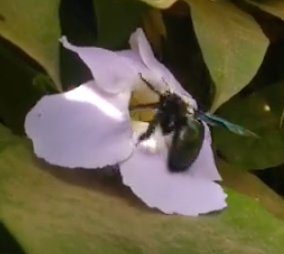Bees and Being in Umbria
I've come to appreciate the natural and animal life in Italy, as you can see from my related blog, Life with Animals in Rural Italy. I admit that I've never been very fond of insects: they bite, sting, and annoy. I don't like the sharing the house with wasps, spiders, beetles, and the occasional reptile that wanders in. And they are so are plentiful in rural areas. They fly and crawl in as unwelcome guests. (or perhaps think the house is theirs and I'm the intruder)! In any case, I'm not a bug-fancier. But I've also noticed how the are curiously fascinating to look at.
As a long-time city dweller myself, I'm grateful for the opportunity to live in and enjoy the countryside and rural areas wherever I now live. I intended this painting as a tribute to bees who do their bee-ing in settings that offer little and who struggle against circumstances set against them. I created Tenement Bees (below) as a tribute to bees from crowded urban areas, many of them blighted with neglect and decay.
I do like skimming through the National Geographic, and they are major bug-fanciers. I've also come to appreciate how important bees are to our eco-system. You probably know that, already, so no harping here. What's new for me here in Italy, is that I've notices some incredible bees living outdoors.
I've never seen bees like these before. I wasn't even sure they were bees until I looked it up. I thought they might be beetles because they are so big (easily 1"-2") and as shiny as a tiny new VW beetle car. They are identified as Carpenter Bees because they nest in burrows of dead wood. At the house we're renting, they congregate at the bushes near old wooden railings (perhaps nesting there).
I've learned from a local bee-keeper that these bees are good pollinators, and I've read that they lay the largest eggs of any insect! It's usual for bees live in crowded colonies, but these bees are solitary, especially the male Clint Eastwood types. You can sometimes find female carpenter bees housed alongside their sisters or daughters in small. clusters. I believe the bees living beside our house are of this coffee-klatch variety. Their buzz is evident as they swarm around flower bushes. They're big enough to watch as they extract nectar (photo from internet), and that is really a remarkable thing to see! They don't bother me so long as I'm respectful. You bet I am.
Bees Metaphorically and in Reality
This thinking about bees has led me think about being. An obvious segue, right? So what might bees mean to us beings and our life?
Oddly enough, I was familiar with the story that the fleur-de-lis, a French and European symbol of royalty, may be a stylized version of a bee (upside-down), with Napolean as Emperor turning it right-side-up as his insignia. Bees are part of
I hit the books to find out more and here are some bits of interest. Bees often appear in world mythologies as an archetype of internal order (rulers might like symbol). As well, they function as symbolic creatures connecting the natural world to the under-world or other-world, conveying themes of immortality, resurrection, and fertility. Such ideas occur in inscriptions and drawings of ancient near-east and ancient Aegean as well as Mayan cultures, among others.
More contemporary uses: bees are in official insignias conveying industriousness /hard-work (Manchester), and can signify working-class ethics and/or "peaceful until you mess with me" in the world of contemporary tattoos.
North American has certainly gotten stung into action, in cities as well as rural areas, to promote the welfare of bees (and human beings as their beneficiaries. In Margaret Atwood's jolting novel, After the Flood, bees are helpful creatures to nurture in a world gone ecologically and in other respects mad.
I now have a different attitude towards bees. I walk here in Umbria along a the path of a once active apiary near our house (now unattended but still with bees present). I no longer do I scurry along in trepidation but feel calm, with respectful admiration that they remain.. I wouldn't be so presumptuous as to call us friends, but I do my best not to bother them or make a fuss when they cross my path. It encourages me to hear them, knowing there will be more flowers and honey because of them.
Among our first house gifts, here in the Umbrian countryside, were a jar of honey made by bees on this land and a flask of olive oil from these trees. Talk about eating well Italy, indeed!
A Honeyed Recipe
Struffoli are Italian honey-ball fritters. They are golden balls of dough drizzed with honey and best served warm. Typically served at Christmas time in Italy, they're a treat whenever in need. Click here for recipe in English.












